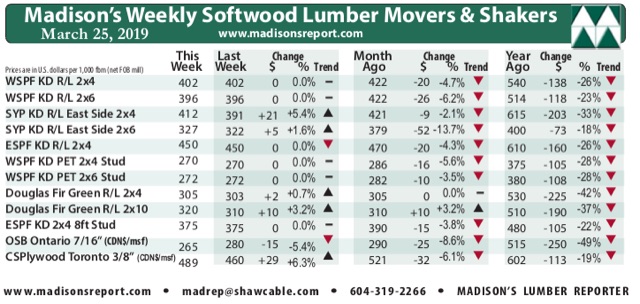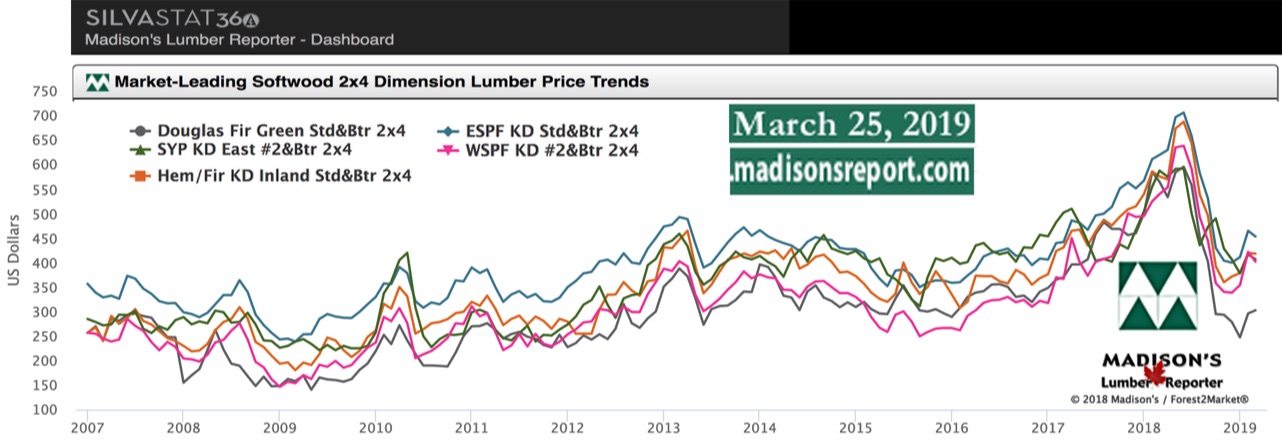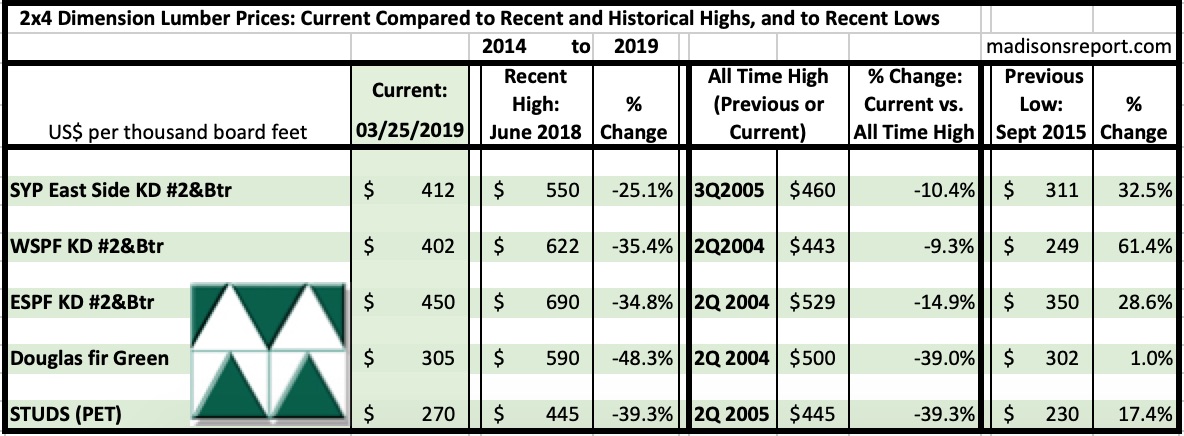
Industry News
Markets
Pent-up demand, transportation woes keep softwood lumber inventories stocked
March 26, 2019 By Madison's Lumber Reporter

Most lumber talk was about the fabulous Montreal Wood Convention last week, a great event which draws sawmill industry folks together every year. Players there reported well-stocked inventories but a lag in production because deliveries to many parts of the U.S. were stymied. Severe flooding has taken over large swaths of the midwest and the northeast. Rail lines continue flooded and bridges are washed out all over the midwest, so important transportation hubs like Memphis, Tenn., and Chicago, Ill., are experiencing severe delays, backlogs, and lack of rail car arrivals. Be ahead of these data releases! Don’t delay, this week’s softwood lumber market comment was published to the website Monday morning.
* Madison’s Lumber Prices, weekly, are a good forecast indicator of U.S. home builder’s current lumber buying activity.
Transportation backlog stalls lumber shipments: spring snowmelt
Due to a very deep snowpack over this winter, then sudden, much warmer temperatures, the usual high-water during spring on rivers all across the middle of the continent have completely overflowed. These powerful waters are carrying big chunks of solid ice, which are destroying transportation infrastructure whether roads, bridges, or rail lines. Suppliers have slowed production and are waiting to see what happens with renewed ordering once their current, already sold, inventory is sent out. Lumber inventories were apparently “backing up” at the secondary supplier level. Wholesalers and distributers had plenty of wood sold, but getting it on the rails with any semblance of punctuality was a frustrating challenge.
Logistics played a key role as to what price you could attain. Quick shipments from the reload commanded a better number while later shipments invited cheaper prices. — A lumber trader (wholesaler)
Investment firm Susquehanna Financial Group has estimated that weekly rail volumes in mid-March originating or starting out of the western U.S. were -13% lower compared with the same period a year ago, according to Freight Waves March 21. In contrast, rail volumes originating from the eastern US were -2.2% higher.
While standard grade Southern Yellow Pine prices corrected upward this week after significant volatility this year, most benchmark construction framing softwood lumber prices remained flat over the past couple of weeks. Print Friday by Madison’s Lumber Reporter on benchmark Western Spruce-Pine-Fir KD 2×4 #2&Btr (wholesaler price, net FOB sawmill) was again unchanged from the week before, still at US$402 mfbm. This is -5% lower than in mid-February when that price was $422, and a -25% drop from one year ago’s U.S.$540 mfbm. By comparison, the recent high for WSPF 2x4s, in June 2018, was U.S.$550 mfbm.
The below table is a comparison of recent highs, in June 2018, and current March 2019 benchmark dimension softwood lumber 2×4 prices compared to historical highs of 2004/05 and compared to recent lows of Sept. 2015:
Spring 2019 building season
General consensus is that the full scope of lumber ordering for this year’s building season hasn’t happened yet. Last month this was because the high-density areas of the U.S. east, Texas, and California, were either still in a freeze or were undergoing a deluge. Building activity slowed or stopped entirely in many key softwood lumber consuming markets. Currently it is the suppliers who can’t get their wood out, so no one really knows how strong demand will be once these logistics issues get sorted out.
Rail car availability and delayed arrivals were so bad that getting even prompt stock moving could take up to three weeks. — Madison’s Lumber Reporter
BNSF has alerted customers that multiple subdivisions remain out of service in Iowa, Missouri, and Nebraska due to high water and track washouts. Service has been restored along lines between Lincoln and Alliance, Neb., and Sioux City, Iowa, to Sioux Falls and Aberdeen, S.D. However, service still remains offline on other subdivisions near Sioux City and Lincoln and Omaha, Neb. The rail company also said it is monitoring areas along the Missouri and Mississippi rivers that are at risk for service outages in the days ahead.
For its part, UNP is also still experiencing delays on subdivisions in Iowa and Nebraska. While the Omaha and Columbus subdivisions in Nebraska were expected to reopen by the end of last week as flood waters receded, the Lincoln subdivision in Nebraska may not reopen until this week. There were no reopening dates set for the Falls City subdivision between Council Bluffs, Iowa, and Kansas City, Kan.
As well, Norfolk Southern said flooding in Hannibal, Mo., has affected rail and intermodal service between Decatur, Ill., and Kansas City, Mo.
These transportation problems also affect farmers and the agriculture industry in the US. Forest industry players — rightly — worry that, once rail service is restored, wood products will be given a lower priority. It is often the case that railways favour perishables or otherwise seasonal products over lumber and other building materials. As well, oil companies often offer a premium on rail rates to move their product faster, so sawmills end up waiting even longer for their own, already scheduled, rail cars to eventually arrive.
Print this page

